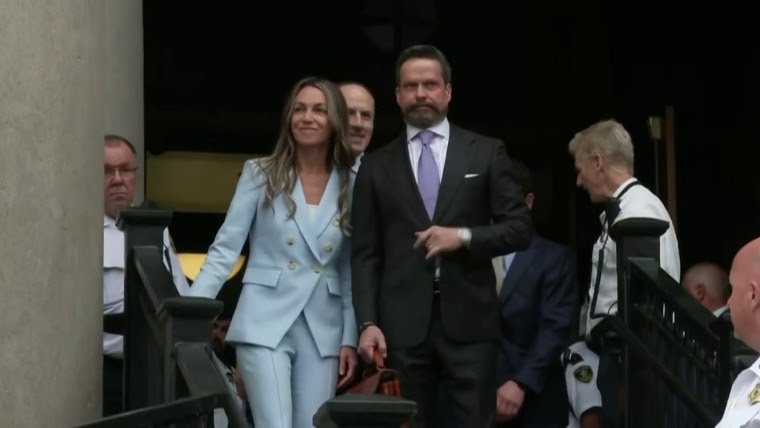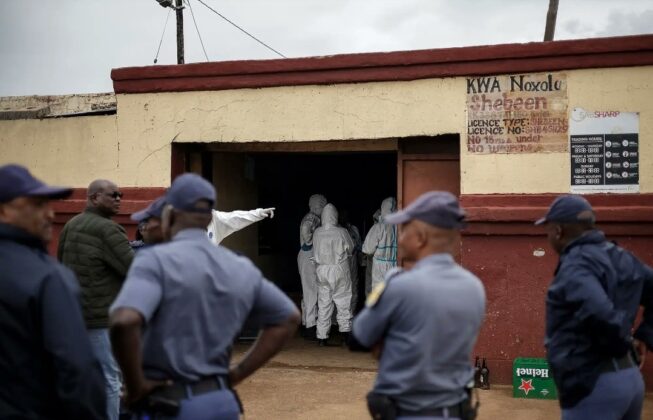
Karen Read stepping out a free woman on June .her release was met with jubilation by "Punk Tide" supporters, underscoring the deep emotional investment and fervent public backing that defined her unique legal saga . Credit: NBC News
(The Post News)- The screams of jubilation were unmistakable. They ripped through the air outside the Dedham courthouse, so loud they could be heard inside, even as the final words of the verdict were read. Karen Read, accused of the second-degree murder of her boyfriend, Boston police officer John O’Keefe, was found not guilty of the most serious charges. Clad in her signature pink and embracing her legal team, she walked out a free woman, her voice thick with emotion as she thanked the cheering throng for their years of “financial, and more importantly emotionally” unwavering support. Yet, as the O’Keefe family departed without comment, their silence echoed a stark, painful truth: the legal trial may be over, but the cultural trial of Karen Read is just beginning its next, tumultuous chapter.
This wasn’t merely a courtroom drama; it was a saga meticulously dissected, passionately debated, and fiercely defended across social media platforms, transforming a tragedy into a consuming public spectacle. As Eric Schiffer, a seasoned public relations expert, aptly put it, Read’s story “blends every dopamine trigger – small-town cops, alleged cover-up, influencer sleuths.” It’s a potent cocktail that taps into our deepest curiosities about justice, conspiracy, and human drama, amplified by the relentless churn of the digital age.
Schiffer’s insights cut to the heart of how public perception is now forged. “Crisis messaging today isn’t about press releases – it’s about Reddit flair mods and who controls the subreddit sidebar narrative,” he explained. The “JusticeforKarenRead” subreddit, swelling to nearly 20,000 members, stands as a testament to this new paradigm. Here, and across TikTok, X (formerly Twitter), and YouTube, complex legal arguments were distilled into viral clips, memes, and impassioned discussions. “Armchair detectives” emerged, poring over every detail, spinning theories, and often outpacing traditional news outlets in their speed and raw, unfiltered reach.
Central to this cultural phenomenon was Aidan Kearney, the blogger known as “Turtleboy.” Kearney quickly became a prominent, albeit controversial, voice in the “Free Karen Read” movement. He passionately championed Read’s innocence, aggressively promoting narratives of a “frame-up” and a pervasive “police cover-up.” His persistent accusations against law enforcement and his undeniable ability to rally a significant online following played a crucial role in shaping a powerful counter-narrative, fueling the public’s distrust in official channels. Kearney himself faced multiple charges of witness intimidation related to his coverage, a stark reminder of the volatile intersection of online advocacy and real-world legal proceedings.
The “Free Karen Read” movement itself became the vibrant, physical embodiment of this online fervor. Clad in Karen Read’s favorite color, pink, supporters converged outside the courthouse daily, their chants and slogans a constant, rhythmic drumbeat against the courtroom walls. Their vocal advocacy created an undeniable presence, fueling the public’s fascination and providing a visible, emotional counterpoint to the prosecution’s case. Karen Read’s own words, thanking these “amazing supporters” for their years of “financial” backing – with defense funds reportedly topping $1.1 million raised through platforms like GoFundMe – underscore just how deeply the public invested, not just emotionally, but tangibly, in her cause. This wasn’t passive observation; it was active, collective support, driven by a powerful belief in her innocence.
The Karen Read trial isn’t an isolated incident but rather the latest, and perhaps most digitally advanced, chapter in the evolution of the true crime genre. Before social media reached its current omnipresence, the HBO documentary The Jinx famously demonstrated how true crime entertainment could directly intersect with, and even influence, real-world legal outcomes. Robert Durst’s unwitting “confession” caught on a hot mic in the documentary’s finale led to his arrest, showcasing the unprecedented power of narrative to impact justice. The Karen Read trial took this concept further, unfolding live, almost like a reality show, with the audience as active participants rather than passive observers. This constant stream of information, combined with the innate human desire for mystery, perceived injustice, and resolution, explains why such cases exert a powerful pull on our collective consciousness.
Even with the verdict delivered, the “cultural trial” persists. The public reactions were immediate and intensely polarized; joyous celebrations from Read’s supporters contrasted sharply with the O’Keefe family’s profound disappointment, who called the verdict a “devastating miscarriage of justice.” Adding to the complexity, jurors themselves have begun to speak out. One juror, Paula Prado, a lawyer from Brazil, initially thought Read might be guilty but ultimately felt there were “too many holes in the prosecution’s case.” She stated, “He definitely went inside and something happened inside the house,” fueling the alternative narratives about the night. Jurors also admitted they knew “all eyes were on them,” highlighting the immense pressure exerted by the surrounding public fervor. Prado’s message to the O’Keefe family was poignant: “Please, keep fighting… The investigation was sloppy, believe that. Look at yourself and keep fighting to find out who did this to him, because he seemed to be a very nice guy.” These juror statements, aired on platforms like Court TV, directly feed the ongoing debate about investigative integrity and the true circumstances of O’Keefe’s death.
Looking ahead, the case remains far from settled. Karen Read still faces a civil wrongful death lawsuit filed by the O’Keefe family in Plymouth Superior Court, seeking at least $50,000 in damages. This ensures continued legal proceedings and media attention, albeit under a different burden of proof. Furthermore, the true crime machine is already at work: Netflix has announced a new untitled documentary currently in production, promising to revisit the saga. Already, “A Body in the Snow: The Trial of Karen Read” is available on Max and Hulu, ensuring that the Karen Read story will be continuously re-examined, re-narrated, and re-consumed as entertainment for years to come.
From our standpoint here in South Africa, the global reach of such “cultural trials” is undeniably clear. Just as South Africa has witnessed its own high-profile cases become the subject of compelling true crime podcasts like “True Crime South Africa” and gripping documentaries like “Tracking Thabo Bester,” the universal allure of dramatic legal battles, framed by narratives of good versus evil and justice sought, transcends borders. The Karen Read case stands as a stark and compelling example of how, in the digital age, the lines between criminal justice, news, and entertainment have irrevocably blurred, creating a societal phenomenon where the verdict in the courtroom is merely one powerful, but not final, chapter in an ongoing cultural narrative.



